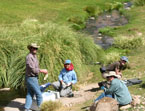Jackson School of Geosciences Technical SessionSeries
Geosciences Building (JGB), Boyd Auditorium, Room
2.324, UT-Austin Campus
ENCOMPASS invites you to the upcoming
Technical Talk, Tuesday, March 1st from 4-5pm.
Doctoral Candidate Megan Franks
"The diversity and distribution of Archaea at El Tatio Geyser Field, Chile"
broadcast live
at this URL
The objective of this research is to rapidly assess
human-natural system interactions for a geothermal basin.The confluence of a recent surprise event at El Tatio geyser
field in the Atacama Desert of northern Chile paired with access to
innovative scientific measurements of key basin indicators provides an
opportunity observe behaviors for interacting human-natural systems.
Using mixed-methods to integrate physical and social
perspectives, this research looks at “How do people perceive vulnerability in the geyser field and frame
possible consequences and/or solutions for managing the multi-attribute
tradeoffs needed to define a management scenario?”
Concurrently, the research will attempt to include
preliminary interviews with representatives from municipal governments,
environmental interests, energy development, tourism industry, national
government ministries, local pueblo community members, research scientists
studying the geothermal system, and tourists about the perceived impact of
the event and the future geothermal development on tourism and the local
economy as well as other issues.
The physical system hypothesis is that this event
offers a chance to see what the long term geothermal energy development
might do to the thermal and hydraulic balance of the geyser field, and that
the changes in flow or chemistry of the geysers now might be similar to the
future changes after the power plant goes on-line.
Program Support
Research in II Region of Chile has been supported by the LIFT: The Longhorn Innovation Fund for Technology and the Geology Foundation of the John A. and Katherine G. Jackson School of Geosciences.
If you would like to learn more about the program, contact Suzanne A. Pierce


